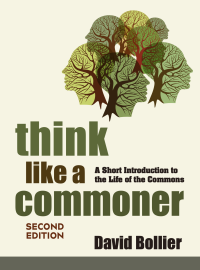I find it fascinating that artists — whose creative work depends so greatly on their cultural environment — can be incredibly possessive in trying to lock up their own works. At a conference of folk singers and songwriters that I attended last year, a remarkable number of them jealously claimed ownership in songs that clearly were derived from the great river of shared folk tunes: our common inheritance.
This impulse is not so surprising, given the predatory habits of the recording industry. Copyrights are one of the few things artists can lay claim to (if only as a temporary bargaining chit in dealings with record companies). But you would think that more artists would realize that their creative output does not and cannot exist in grand isolation from the larger culture. There is a necessary symbiosis. Woody Guthrie was a rarity: he considered it the highest honor when his songs were absorbed into the culture without anyone even realizing his authorship.
These thoughts occurred to me as I read excerpts from a forthcoming report, “Will Fair Use Survive? Free Expression in the Age of Copyright Control.” The report will be released in December by the Free Expression Policy Project at NYU’s Brennan Center for Justice. (To order one of more free copies, email kafayat@nyu.edu.) The report draws upon dozens of firsthand stories from filmmakers, scholars, bloggers and others to show how our intellectual property system is dangerously out of balance. The report also describes the bullying use of cease-and-desist letters, the excesses of the Digital Millennium Copyright Act, and the whole “clearance culture” that is stifling new creativity, particularly in film making.
This is not breaking news, to be sure, but we need rigorous empirical evidence of these trends, and this report does just that. It is a well-researched, amply footnoted compilation of stories that collectively demonstrate how badly we need IP reform — and how imperiled the public’s traditional fair use rights are.
Here’s one such story from the Fair Use report: In 2004, artist Joy Garnett pulled together dozens of images from the mass media for an exhibit of paintings that she called “Riot,” which featured images of people in extreme emotional states. One of the images derived from a 1981 photograph by Susan Meiselas that showed a pony-tailed hippie in a beret and a cross around his neck, throwing a Molotov cocktail in a Pepsi bottle.
When Meiselas and her lawyer learned of the exhibit, they accused Garnett of pirating the photo, and asked her to sign a retroactive licensing agreement that would sign over all rights to the painting to Meiselas. When Garnett refused (claiming her painting was a transformative fair use of the Meiselas photo), Meiselas’ attorney responded with a very aggressive, twelve-page letter demanding that Garnett pay $2,000. That was enough to persuade Garnett to pull the photo from her website, lest it result in her entire website being pulled down.
But that wasn’t the end of the story.
“Here’s the punch line,” recalled Garnett. “Seconds before I took the images off, people on Rhizome [an artists’ website] grabbed my images in solidarity. They copied the html and uploaded pages to their Web sites; then one of these artists takes my painting, a JPEG painting, and flips it. He puts it up on his site, and now it’s a derivative work on my work. And everybody went for it. So everyone started making digital collages based on the Molotov image. It all turned into agitprop, protest art. They translated the story into Italian, Czech, Chinese, Spanish, French, Catalan.
“It got me on a lecture tour, actually. But the weird thing is that the lawyer wrote to thank me for removing the images from the Web site. In the meantime, over the next five months, this image went global.”
A case of simply piracy? I don’t think so. It’s a demonstration of the elemental fact that culture is a shared endeavor. Artistic innovation, creative communities, culture — none could work without an open commons of access and sharing. (Did Susan Meisalas pay the Catholic Church for her depiction of the cross, or Pepsi for depicted its trademarked can?)
An absolute lockup of a creative work — requiring advance permission and payment to use or re-use — is not only impossible in the digital age. It flouts the social identity of art works. A work has no meaning or emotional resonances without a social community. And future progress requires access and re-use. Certain public needs matter. That’s why the fair use doctrine exists.
I recommend the FEPP report. And for another good read on this topic, check out Michael Madison’s forthcoming essay, “A Pattern-Oriented Approach to Fair Use,” in the William and Mary Law Review.











Recent comments